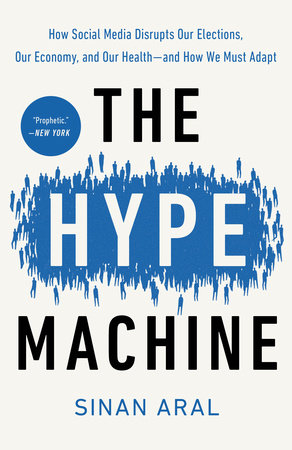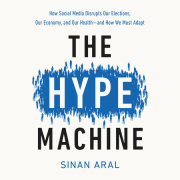Chapter 1The New Social AgeThis is the whole point of technology. It creates an appetite for immortality on the one hand. It threatens universal extinction on the other. Technology is lust removed from nature. —Don DeLillo
Human beings have always been a social species. We’ve been communicating, cooperating, and coordinating with one another since we were hunting and gathering. But today something is different. Over the last decade, we’ve doused our kindling fire of human interaction with high-octane gasoline. We’ve constructed an expansive, multifaceted machine that spans the globe and conducts the flow of information, opinions, and behaviors through society. This Hype Machine connects us in a worldwide communication network, exchanging trillions of messages a day, guided by algorithms, designed to inform, persuade, entertain, and manipulate us.
The object of this machine is the human psyche. It was designed to stimulate our neurological impulses, to draw us in and persuade us to change how we shop, vote, and exercise, and even who we love. It analyzes us to give us options for what to read, buy, and believe. It then learns from our choices and iteratively optimizes its offerings. As it operates, it generates a data exhaust that traces each of our preferences, desires, interests, and time-stamped, geolocated activities around the world. It then feeds on its own data exhaust, refining its process, perfecting its analysis, and improving its persuasive leverage. Its motivation is money, which it maximizes by engaging us. The more precise it gets, the more engaging and persuasive it becomes. The more persuasive it becomes, the more revenue it generates and the bigger it grows. This is the story of the Hype Machine—the social media industrial complex: how it was designed, how it works, how it affects us, and how we can adapt to it. And the story opens in Crimea.
Ten Days
On a cold day in February 2014, heavily armed gunmen surrounded the Crimean parliament building in Simferopol, Ukraine. They wore no sovereign markings but were later confirmed to be Russian special forces reacting to the deposition of Ukrainian president Viktor Yanukovych just days before. By all accounts, the gunmen were organized and professional. After breaking through the front door, they cut the building’s communications, confiscated all mobile electronic devices, and systematically controlled who entered and exited the building, maintaining a tight perimeter and allowing no foreign journalists inside.
A few hours later, amid reports of heavy intimidation and fraud by the gunmen inside, the Crimean parliament voted to dissolve the government and replace Prime Minister Anatolii Mohyliov with Sergey Aksyonov, whose pro-Russian Unity Party had won only 4 percent of the vote in the previous election. Less than twenty-four hours later, similarly unmarked troops occupied the Simferopol and Sevastopol international airports and set up checkpoints on Crimean roads throughout the region. Two days later Aksyonov, who had earned the nickname “the Goblin” during his days as a businessman with ties both to the Russian mafia and to pro-Russian political and military groups, wrote a personal letter to Vladimir Putin, in his new capacity as the de facto prime minister of Crimea, formally requesting Russian assistance in maintaining peace and security there.
Before the Ukrainian government could declare Aksyonov’s appointment unconstitutional, pro-Russian protests were whipped up throughout Crimea, developing a groundswell of visible support for reunification with Russia. The sentiment seemed one-sided, with many in Crimea expressing a strong desire to return to Russia. Within hours of Aksyonov requesting assistance, Putin received formal approval from the Russian Federation Council to send in troops. The Russian consulate began issuing passports in Crimea, and Ukrainian journalists were prohibited from entering the region. The next day Ukrainian defenses were under siege by the Black Sea Fleet and the Russian Army. Five days later, just ten days after the ordeal began, the Supreme Council of Crimea voted to re-accede to Russia after sixty years as part of Ukraine.
It was one of the quickest and quietest annexations of the postwar era. As former secretary of state Madeleine Albright testified, it “marked the first time since World War II that European borders have been altered by force.” In just ten days, the region was flipped, like a light switch, from one sovereignty to another with barely a whisper.
The debate about what happened in Crimea continues today. Russia denies it was an annexation. Putin views it, instead, as an accession by Crimea to Russia. His adversaries claim it was a hostile encroachment by a foreign power. In essence, there was a dispute over the will of the Crimean people—a clash of competing realities, if you will. On the one hand, Russia claimed Crimean citizens overwhelmingly supported a return to the Russian Federation. On the other hand, pro-Ukrainian voices claimed the pro-Russian sentiment had been orchestrated by Moscow rather than by the people themselves.
Framing the Crimean reality was essential to restraining foreign intervention in the conflict. If this was an annexation, NATO would surely have to respond. But if this was an accession, overwhelmingly supported by the Crimean people, intervention would be harder to justify. So while the clandestine military and political operations were ruthlessly organized and flawlessly executed, Russia’s information operation, designed to frame the reality of what happened on the ground in Crimea, was even more sophisticated, perhaps the most sophisticated the world had ever seen. And when it came to framing that reality, social media—what I call the Hype Machine—was indispensable.
The Spread of Fake News Online
To communicate my perspective on Crimea, I have to first take you on a detour, through a story within a story, to give you some context for how I understand the events that unfolded in Ukraine. In 2016, two years after the annexation of Crimea, I was in my lab at MIT, in Cambridge, Massachusetts, hard at work on an important research project with my colleagues Soroush Vosoughi and Deb Roy. We had been working for some time, in direct collaboration with Twitter, on what was then the largest-ever longitudinal study of the spread of fake news online. It analyzed the diffusion of all the fact-checked true and false rumors that had ever spread on Twitter, in the ten years from its inception in 2006 to 2017.
This study, which was published on the cover of Science in March 2018, revealed some of the first large-scale evidence on how fake news spreads online. During our research, we discovered what I still, to this day, consider some of the scariest scientific results I have ever encountered. We found that false news diffused significantly farther, faster, deeper, and more broadly than the truth in all categories of information—in some cases, by an order of magnitude (Figure 1.1). Whoever said “a lie travels halfway around the world while the truth is putting on its shoes” was right. We had uncovered a reality-distortion machine in the pipes of social media platforms, through which falsehood traveled like lightning, while the truth dripped along like molasses.
But buried in these more sensational results was a less obvious result, one that is directly relevant to Crimea. As part of our analysis, before building more sophisticated models of the spread of true and false news on Twitter, we produced a simpler graph. We plotted the numbers of true and false news cascades (unbroken chains of person-to-person retweets of a story) in different categories (like politics, business, terrorism, and war) over time. The total spread of false rumors had risen over time and peaked at the end of 2013, in 2015, and again at the end of 2016, corresponding to the last U.S. presidential election. The data showed clear increases in the total number of false political rumors during the 2012 and 2016 U.S. presidential elections, confirming the political relevance of the spread of false news.
But another, more subtle result also drew our attention. Over the ten-year period from 2006 to 2017, there was only one visible spike in the number of rumors that contained both partially true and partially false information, which we called “mixed” rumors. In the original graph, opposite, it was difficult to see. So we filtered the data and replotted the graph, this time considering only political news. That’s when we saw it—a single, clear spike in the spread of stories that contained partially true and partially false information in the two months between February and March 2014. It corresponded directly to the Russian annexation of Crimea.
This result was striking, not just because it was the largest spike of mixed news in the history of verified stories spreading on Twitter (and more than four times larger than any other spike in mixed political news), but also because it ended almost as quickly as it began, right after the annexation was complete. When we investigated further, we discovered a systematic appropriation of social media by pro-Russian entities that proactively used the Hype Machine to control the Ukrainian national perception of the events in Crimea, and the international perception of what was happening there, to ultimately frame the will of the Crimean people.
Copyright © 2020 by Sinan Aral. All rights reserved. No part of this excerpt may be reproduced or reprinted without permission in writing from the publisher.






